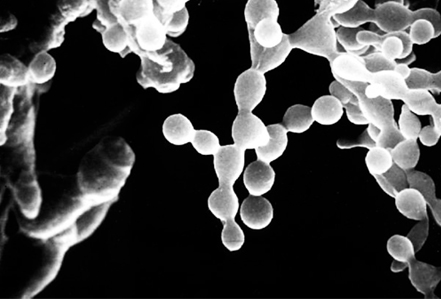

instituto de biologia molecular e celular | institute for molecular and cell biology
Previous Research Results:
Our laboratory has been interested in the molecular biology of mitochondria, the organelle responsible for the generation of most cellular energy. In particular, we have been studying the bioenergetics processes using the filamentous fungus Neurospora crassa. We have identified and characterized all respiratory chain NADH dehydrogenases from Neurospora, namely the proton-pumping complex I and the four alternative NAD(P)H dehydrogenases (one internal and three external enzymes). We found that complex I is essential for sexual development and the alternative enzymes are important for the germination of both sexual and asexual fungal spores. We also described the composition of the fungal complex I (about 40 proteins). We have defined the role of many of theses polypeptides in the assembly, structure and function of complex I. We also generated fungal models of human mitochondrial disease associated with complex I, finding that some mutations result in diminished levels of the enzyme rather than affecting its activity.
We have also identified and determined the cellular location and characterized of all FKBP proteins (ligands of immunossupressant FK-506) from Neurospora crassa, unraveling some of their roles within the cell. We cloned two proteins (enolase and NAD+ synthetase) from Streptococcus sobrinus, an agent of dental caries, which affect the mice immunological system. We identified and collected Neurospora species from nature for the first time in Europe, participating in a study of fungal diversity at continental scale. We also showed that N. crassa can be used as a model organism to investigate programmed cell death.

IMAGE: Images of the flamentous fungus Neurospora crassa
Future research goals:
Mitochondria are crucial for the life of organisms, through its capacity for energy production and regulation of other cellular processes, but also have a central role in programmed cell death (PCD). The death program is essential for the development of metazoan organisms and its dysfunction may result in human disease, like cancer. Our main objective for the future is the characterization of genes/proteins and mechanisms involved in programmed cell death, with particular emphasis in the mitochondrial involvement. We anticipate that knowledge about novel processes associated with programmed cell death will be useful to develop drug combinations that can be used as anti-fungal and/or anti-tumor agents. For this, we plan to establish and use the filamentous fungus Neurospora as a model organism to investigate PCD. We also plan to continue the characterization of mitochondrial proteins/complexes, with particular emphasis in respiratory chain components, and their role in mitochondrial biogenesis and function.
Selected References:
Carneiro, P., Duarte, M. and Videira, A. (2007). The External Alternative NAD(P)H Dehydrogenase NDE3 is Localized both in the Mitochondria and in the Cytoplasm of Neurospora crassa. Journal of Molecular Biology 368, 1114-1121.
Castro, A., Lemos, C., Falcão, A., Glass, N.L. and Videira A. (2008). Increased resistance of complex I mutants to phytosphingosine-induced programmed cell death. The Journal of Biological Chemistry 283, 19314-19321.
Duarte, M. and Videira, A. (2009). Effects of mitochondrial complex III disruption in the respiratory chain of Neurospora crassa. Molecular Microbiology 72, 246-258.
Videira, A., Kasuga, T., Tian, C., Lemos, C., Castro, A., and Glass, N.L. (2009). Transcriptional analysis of the Neurospora crassa response to phytosphingosine reveals links to mitochondrial function. Microbiology 155, 3134-3141.
Castro, A., Lemos, C., Falcão, A., Fernandes, A.S., Glass, N.L. and Videira, A. (2010). Rotenone enhances the antifungal properties of staurosporine. Eukaryotic Cell 9, 906-914.
Gonçalves, A.P., Máximo, V., Lima, J., Singh, K.K., Soares, P. and Videira, A. (2011). Involvement of p53 in cell death following cell cycle arrest and mitotic catastrophe induced by rotenone. BBA-Molecular Cell Research 1813, 492-499.
Home | Site Map | Contacts | Credits | Privacy & Cookies | WHISTLEBLOWER CHANNEL | Intranet | Social Networks |
